Introduction: Biodiversity Depleted yet Rich
Lying just south of the Tropic of Cancer, and with a sub-tropical climate – summers are hot and humid, winters tend towards temperate – Hong Kong has a mostly tropical flora and fauna. Though there has been significant damage to land and marine habitats, there is a wealth of biodiversity, particularly given the land area is only around 400 square kilometres.
On land, there are around 240 species of butterflies, 110 species of dragonflies, 3000 species of moths, 160 species of freshwater fish, 100 species of amphibians and reptiles, 480 species of birds, and 50 species of mammals, roughly half of which are bats. Among some 2100 species of native vascular plants are more than 150 tree species – over four times as many as Britain.
Marine biodiversity is high, too. For instance, there are 88 species of hard corals – representing over 10 percent of the world’s total, and more than in the entire Caribbean – and 320 species of reef fish.
Other marine creatures include Finless Porpoise Neophocaena phocaenoides – an Asian species considered endangered in China – and Chinese White Dolphin Sousa chinensis. The dolphin, which is actually bubble-gum pink when adult, is one of Hong Kong’s best known species, and became the mascot for Hong Kong’s return to China in 1997.
Hong Kong’s star bird is Black-faced Spoonbill Platalea minor, an endangered wading bird with a world population of around 2100, roughly a third of which stop over on migration or spend winter here. A tiny amphibian, Romer’s Tree Frog Chirixalus romeri, is among the animal species that are unique to Hong Kong. There are endemic plants, too – the Hong Kong Orchid Tree Bauhinia blakeana may be a sterile hybrid, with all those grown today descended from one tree found in Pokfulam, Hong Kong Island, but its flowers gave rise to Hong Kong’s Bauhinia emblem.
The biodiversity stems from Hong Kong’s location within a region that is biologically rich, coupled with variety of habitats ranging spanning marine waters, estuaries, and hills.
South China is unusual among regions lying along the Tropic of Cancer, as no deserts or major mountain ranges interrupted the forests that once extended from the Equator to the Arctic. During warmer, inter-glacial periods, this made the region important for the dispersal of land species, some of which even crossed a land bridge to North America – where there are now populations of animals related to species in China, such as a whip scorpion found in Hong Kong.
Yet south China has also suffered ecological devastation, with great swathes of the landscape cleared of forest. This had a massive impact on biodiversity – for instance, even by the 14th century, elephants roamed areas south of the Yangzi, yet today they are restricted to pockets of forest in southwest China. Hong Kong was likewise deforested, but in recent decades many species that clung on for survival have rebounded in numbers, thanks to reforestation and conservation, particularly on hillsides.
Today, Hong Kong’s secondary woods are surely among the best areas of woodland along the south China coast. Especially around Tai Mo Shan in the central New Territories, where woodland and shrubland on the lower slopes, including in Tai Po Kau reserve, has been designated as an Important Bird Area by Birdlife International.
Also, along coastlines and in inshore waters, Hong Kong has some of the world’s most northerly mangroves and hard corals. The most extensive mangrove stands are at Deep Bay in northwest Hong Kong – which is an internationally important wetland, particularly notable for migratory waterbirds that include rare species such as the Black-faced Spoonbill.
Though marine biodiversity is high, marine life faces severe problems, such as coastal reclamation projects, pollution, and over-fishing. Sharks were once common, yet reef sharks are now scarce visitors. The average weight of fish caught here is just 10 grams or less. Marine protection has lagged behind protection of terrestrial habitats, and there are now various conservation projects, such as to help the handful of Green Turtles Chelonia mydas that still nest in Hong Kong.
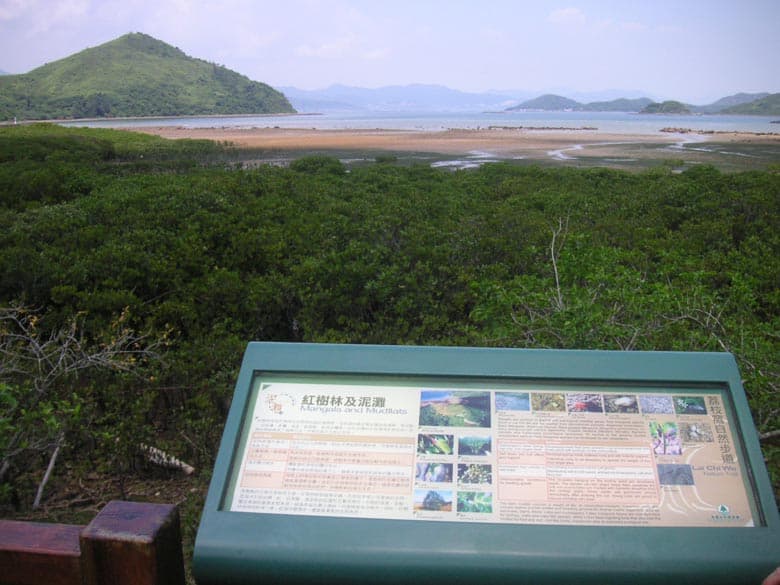
The Hong Kong Geopark sites are all in eastern Hong Kong, away from the heart of terrestrial biodiversity in the central New Territories. Partly as sites are typically exposed to erosive forces such as winds and waves, they are typically poorly vegetated, with expanses of scrub and grassland, so have relatively poor terrestrial biodiversity. But there are some woods, notably at Lai Chi Wo beside Double Haven, which has one of the best fung shui woods in Hong Kong. Lai Chi Wo also has an excellent stand of mangroves, below which is one of Hong Kong’s few beds of eel grass.
By contrast to the land, the Geopark sites are mostly beside or even surrounded by coastal waters that are home to diverse marine life. An area that has been dubbed the “Coral Triangle” includes two Geopark sites – Double Haven and Tung Ping Chau, with locally important coral communities that hold many of Hong Kong’s hard coral species. Further south, at the Ung Kong Group of Islands, Port Island and the Ninepin Group, the coastal waters are more turbulent, and there are fewer hard corals. Some islets, including in the Ninepin Group, hold small colonies of terns.
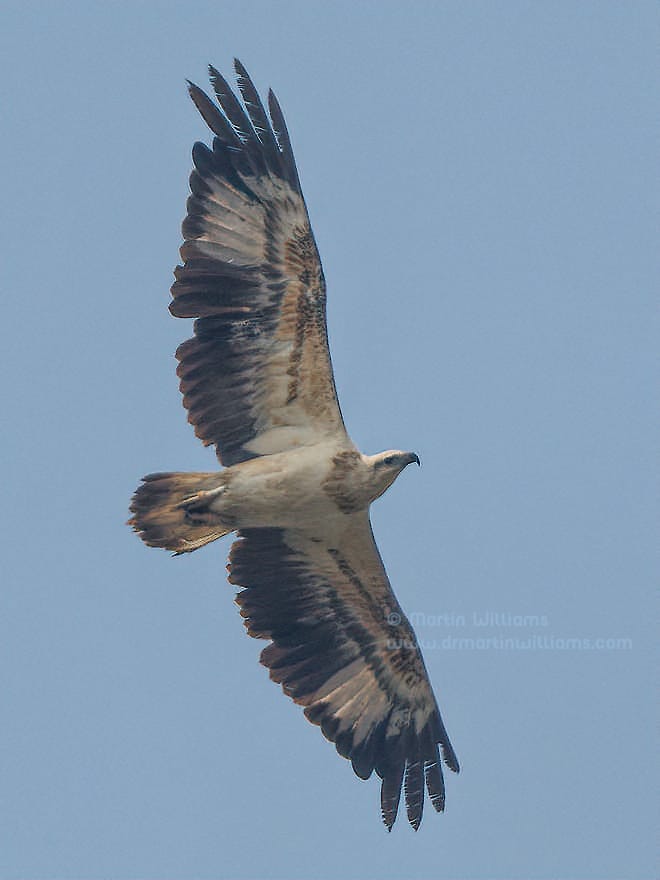
The entire Geopark is within the realm of one of Hong Kong’s most magnificent birds – the White-bellied Sea-Eagle Haliaeetus leucogaster. With their white tails and bodies contrasting with broad wings that are grey above and black and white below, the adults are large, striking birds of prey that soar over coastlines, islands, and stretches of sea. This eagle is surely the most emblematic of all the Geopark’s plants and animals.
A Brief History of Hong Kong’s Terrestrial Biodiversity
As the last ice age ended around 10,000 years ago, ice sheets the size of continents melted, and sea level rose. Along south China, the sea flooded in across a sub-tropical coastal plain. Reaching the land that is now Hong Kong, the sea changed valleys into bays and inlets, hilltops into islands.
For some species, these Islands served as havens from the flood; a few survived on one or more Hong Kong islands, yet are found nowhere else on earth. The best known of the castaways is Romer’s Tree Frog Chirixalus romeri. First discovered on Lamma Island by amateur herpetologist John Romer in 1952, it has since been found on Lantau Island, Po Toi, and Chek Lap Kok – which was largely destroyed to make way for the Hong Kong International Airport. Though not spectacular looking – it is dull brown and, even when full grown barely reaches half the length of the average human thumb – Romer’s Tree Frog shot to prominence when work was underway on levelling Chek Lap Kok, and some individuals were rescued. Other ice age survivors include an earthworm-like burrowing lizard that’s only known from two islands in western Hong Kong, and a gecko discovered on Po Toi, south of Hong Kong Island, in 1992.
Sea level stabilised around 6000 years ago. At that time, Hong Kong’s hills and valleys, flat land and islands were surely forested. No certain trace of these ancient forests now remains but – helped by evidence such as fossil pollen – we can guess how they might have appeared.
The forests were sub-tropical, dense and lush, dominated by evergreen trees belonging to the oak and laurel families. There were sawtooth oaks, bamboo-leaved oaks, thick-leaved oaks and small-leaved oaks. There were white oaks and chestnut oaks, and spiny, hairy, wild and thorny chestnuts. There were at least 16 species of tanbarks, as well as camphor trees, cinammon trees, litseas with round leaves and with long leaves, and winter-flowering fragrant litseas.
At lower elevations, the forests were mostly tropical in nature; those growing higher more resembled forests we find further north, in temperate regions. Especially on exposed ridges, where they were trimmed by winds that blew in from the northeast in winter and from over the South China Sea in summer, the trees in these upland forests grew to only modest heights. Even the lowland forests held few true giants – the erratic, violent visitations by typhoons removed upstarts that thrust too high above their neighbours.
The forests were home to a great diversity of wildlife, including Asian Elephants Elephas maximus, South China Tigers Panthera tigris amoyensis, leopards, Asiatic Wild Dogs Cuon alpinus, macaques, gibbons, pythons, and giant moths. Maybe there were also rhinoceroses, exotic pheasants and hornbills.
Although much of our picture of these forests stems from educated guesswork, this we do know: the forests were destroyed by man.
We cannot know when the destruction began; Hong Kong’s early history is just too hazy. Fossils show that early humans inhabited Guangdong province at least 140,000 years ago, and it is likely that Hong Kong’s forests were long home to people. These people may have changed the forests over time, such as by farming practices involving clearing patches of forest, growing crops, and moving on to other areas.
Trees would have been felled to help fuel the lime kilns that dotted the coast from 300-900, Then, during the Song dynasty (960-1279), there was a wave of immigration from the north, as people arrived to settle, and farm. These farmers reputedly spelled the end for most of the remaining forest cover. More settlers arrived during the Ming Dynasty (1368-1644), during which time Incense Trees Aquilana sinensis were cultivated, and the incense that supposedly gave rise to Hong Kong’s name – Heung Gong (Fragrant Harbour) – was exported.
By 1841, when Hong Kong Island and Kowloon were ceded to the British, the forests had evidently been reduced to small patches of secondary growth – mainly on the more remote hillsides – and scattered, utilitarian fung shui groves. Hong Kong Island, which may have been typical of much of the landscape at that time, was, in the words of British foreign secretary Lord Palmerston, “A barren island with hardly a house upon it.”
Yet even with the forests so depleted, an impressive diversity of plants and animals remained. Elephants and gibbons had vanished, but tigers still visited – early last century, individuals terrorised villagers, and one that killed a police sergeant was shot in Stanley, Hong Kong Island. Leopards were rarer; one was trapped and shot in 1931. Wild dogs were reported. There were also Leopard Cats Prionailurus bengalensis, three species of civet cats, foxes, barking deer and Wild Boar Sus scrofa. And, perhaps because they coped better with forest loss and were regarded as auspicious by the locals, there was a good variety of bats, with 21 species recorded last century.
Though the deforestation had benefited open country plants and animals, there were also rare species, clinging on for survival. For them, continued habitat loss could signal a death knell. They needed a reprieve from the wholesale destruction.
Towards the end of last century came just such a reprieve for the forests – albeit a reprieve that was largely restricted to Hong Kong Island, where extensive tree planting began, and cutting trees was prohibited. Much as with the preservation and cultivation of fung shui groves – protected according to principles of Chinese geomancy, though surely providing practical benefits including safeguarding villages from landslides – the reforestation was not for conservation, but to serve human aims. The new forests were to act as sponges, taking the brunt of rainstorms, and releasing the water to reservoirs that supplied a growing population.
The reprieve ended with the Second World War and the Japanese occupation, from December 1941 to August 1945. Desperate for fuel, people felled trees, stripping away many of the remaining woods.
The occupation seems to have marked a watershed in the history of Hong Kong’s forests and their wildlife. Few trees of pre-war age remain. Post war, there have been no reports of wild dogs (though there are domestic dogs gone wild), there has only been one certain tiger – which, in November 1947, walked across the Bishop of Hong Kong’s lawn in Sha Tin – and only one leopard, shot in the north-eastern New Territories in 1957.
But, even as urban Hong Kong has grown apace, the years since the war have seen extensive tree planting, and the natural growth of new, young forests. This renaissance for the forests is widespread; even on the slopes above the city on Hong Kong Island, you can see it underway.
Sai Kung village communities were especially cooperative with the reforestation work that began after the Second World War, so by 1952 the Sai Kung Peninsula was being transformed into one of Hong Kong’s most beautiful forest areas.
A key species planted was Chinese Red Pine Pinus massoniana, but by the 1970s many of the pines were killed by nematode parasites carried by beetles. Broadleaf trees have grown in their place, so there are now expanses of young woodland with native species such as Chinese Tallow Tree Sapium sebiferum, Machilus species, Fragrant Litsea Litsea cubeba, Lance-leaved Sterculia Sterculia lanceolata and Ivy Tree Schefflera heptaphylla.
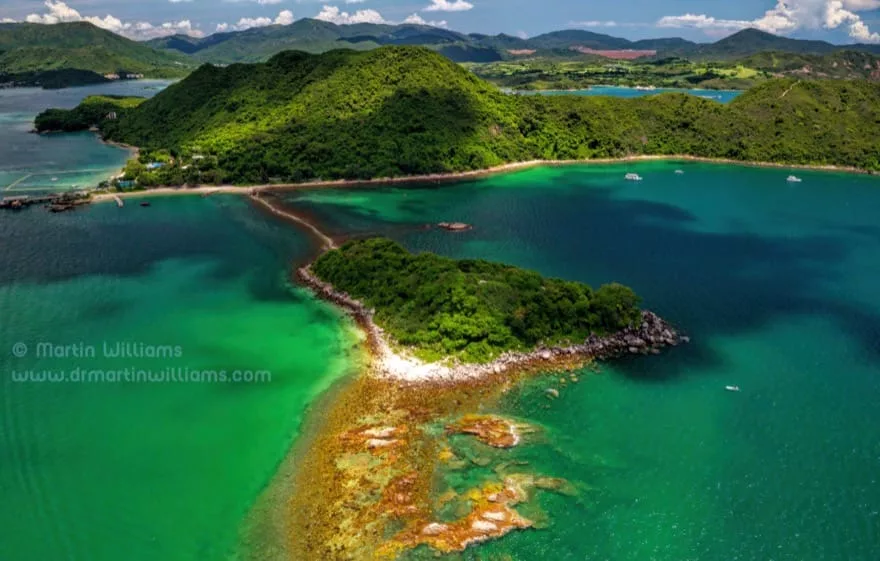
In the late 1970s, following several years of planning, Hong Kong’s first country parks were established. There were 21 in all, four of which at least partly include Geopark sites: Sai Kung East Country Park (includes High Island and Sai Wan), Plover Cove Country Park (includes east shore of Double Haven, Bluff Head, and Ma Shi Chau), Plover Cove Extension Country Park (includes islands of Double Haven, Tung Ping Chau and Port Island), and Kiu Tsui Country Park (Sharp Island – itself a Geopark site). The government was to protect, manage and develop the country parks – with development aimed at proving facilities for public enjoyment, outdoor recreation and tourism, while protecting the vegetation, wildlife and sites of historical and cultural significance within the parks.
There are now 24 country parks in Hong Kong, as well as two special areas – the Tai Po Kau Forest Reserve, and Ma Shi Chau. They protect around 38 percent of Hong Kong’s land area, and are managed by the Agriculture, Fisheries and Conservation Department.
Though country parks are spared from “development” involving concrete, they are not perfect sanctuaries. It is difficult to effectively patrol them, and animals including Chinese Pangolin and the highly endangered Golden Coin Turtle (Three-banded Box Turtle) Cuora trifasciata are trapped, as they have high market values; similarly some people hack wounds into Incense Trees to obtain their resin, and there are occasional reports of people from mainland China uprooting and stealing Buddhist Pines Podocarpus macrophyllus from the Sai Kung Peninsula. Plus, some expanses of hillside are often set alight – especially those near graves that are swept, with incense and offerings burned, during spring and autumn festivals. These fires stop succession to woodland, and on the worst affected slopes little grows except hardy grass.
When the country parks system was devised, many rural villages were still occupied, albeit with people beginning to leave the more remote areas for a better life in the city or overseas. Hence, villages and neighbouring land were excised from the country parks.

Today, many villages are abandoned, and their surroundings are sometimes hotspots for biodiversity, holding species absent from the hillsides typical of country parks. In some places, there are conflicts between plans for developments of village areas, and calls for nature conservation. Some efforts are being made to find solutions; as yet – and in common with experiences typical of the rest of the world – no solution that satisfies both developers and conservationists has been found. Sadly, true ecotourism remains an elusive goal in Hong Kong; the Geopark may help show the way forward, perhaps bringing some benefits to local people, whilst protecting biodiversity as well as geological formations.
A Brief History of Hong Kong’s Marine and Coastal Biodiversity
When the sea rose after the last ice age, it formed a ria coastline at Hong Kong – deeply indented, with bays formed by flooded valleys. Hills and hilltops surrounded by sea became islands that dot inshore waters.
Silt carried by streams and rivers accumulated where they entered the sea, forming estuaries. By far the largest of the rivers in the vicinity of Hong Kong is the Pearl River – which flows to the sea past western Hong Kong, where Lantau is among islands lying in the river mouth. The Pearl River makes waters along western coasts siltier, and less saline, than the more oceanic water to the east. This has affected distribution of marine life: hard corals, which grow best in clear water, are found mainly in the east. Western waters are more notable for the presence of the Chinese white dolphin, and the coastal wetland habitats at Deep Bay, which is really a shallow estuary.
Deep Bay is also the site of Hong Kong’s foremost nature reserve – Mai Po Marshes, which was designated as a Site of Special Scientific Interest in 1976, and became a reserve eight years later. The reserve is managed by the World Wide Fund for Nature Hong Kong and the AFCD. In 1995, Inner Deep Bay was designated as a Ramsar site – receiving national level recognition as an internationally important wetland. Deep Bay is of particular importance as a site where tens of thousands of migratory birds stopover on migration, or visit during winter. Despite the protection, some threats remain, including from intense development along the northern shore, in Shenzhen.
Though Mirs Bay in eastern Hong Kong – where the Geopark sites are located – is far less influenced by the Pearl River’s silty and now polluted water than are western waters, it is not pristine. As the surrounding land was deforested, especially in the last few centuries, silt from increased erosion would have boosted turbidity, perhaps restricting growth of corals, even smothering some.
Mirs Bay was formerly the site of a pearl harvesting industry; indeed, curing the Five Dynasties (907-960 AD) it was known as the “Pearl Pool”. However, the industry devastated oyster beds. Corals and seashells were harvested for another local industry – making lime through baking the coral and shells in kilns. It has even been claimed this led to coral colonies being eradicated by a hundred years ago; even if corals survived, their numbers were surely depleted, and their species composition affected. More recently, corals hare reportedly been collected for ornamental purposes, such as decorating aquariums. These could be additional reasons – on top of the cooler winters – that branching corals are scarce in Hong Kong, even though they dominate coral communities in the South Pacific. Indeed, two coral species that have not been found in Hong Kong since the 1950s – branching coral in the genus Pocillopora and a mushroom coral in the genus Fungia – belong to attractive, sometimes colourful coral families that are popular with people keeping aquariums.
Pollution also impacts marine life. Especially during the 1980s, Tolo Harbour became severely polluted, apparently leading to many corals dying in the inner harbour, as well as some pollution-sensitive species dying in the outer, Tolo Channel. Pollution will have also impacted marine life in Mirs Bay, including as more algae grew, reducing light reaching the seabed. This may explain why it’s now hard to find corals below six metres, yet during the early 1980s corals could be found at depths to over 10 metres in Mirs Bay and Tolo Channel.
The pollution has, however, resulted in a surprising species being found in Tolo Channel. Here, even at relatively shallow depths, the water is so dark that parts of the channel host black corals, which elsewhere in the world are only found at considerable depths, below where most light can penetrate in clean water. Despite their name, these corals – which have tree like forms, and are related to urchins – can be brightly coloured.
Construction projects such as the creation of Sha Tin New Town, which began in the 1970s, have impacted stretches of coastline. Ongoing developments along the north shore of Mirs Bay, including creation and expansion of Yantian container port, add to pressures such as pollution.
Over-fishing is another major problem. Fish stocks have been much reduced, and fish are mostly small, or even tiny. Long-lived, slow-growing fish such as grouper have perhaps suffered most from over-fishing: eight species of grouper were considered fairly abundant around 1970, yet most are rare today.
Destructive fishing practices may also be employed. Dynamite fishing has occurred: explosions kill and stun fish, so they can be readily collected, but also kill other marine life, including corals. While this is illegal, and largely controlled, trawling remains legal, but damaging: vast nets are trailed behind boats, dragging across the seabed where they disturb fish, shrimps and other creatures, which get caught in the nets, and devastate soft corals and other animals living on the seabed. Gill nets may be abandoned, and act “ghost nets” that still catch and kill fish and other marine life.
Some measures have been taken to protect Hong Kong’s marine environment, notably in and near Mirs Bay. These include the establishment of marine parks. The first of these were the 260-hectare Hoi Ha Wan Marine Park, at the southwest corner of the Coral Triangle, and 680-hectare Yan Chau Tong Marine Park – covering southern Double Haven, plus the bay in front of Lai Chi Wo. These were established in 1996; five years later, Tung Ping Chau Marine Park was established to cover 270 hectares of inshore waters around the island. Commercial fishing is among activities that are banned within these parks.
The AFCD has also deployed artificial reefs, at sites including Double Haven and Hoi Ha Wan. Formed of unwanted items such as old boats and clusters of used tyres, these “reefs” become structures that can attract fish and other creatures, and deter bottom trawling as nets may snag and tear. Fish have indeed begun aggregating and breeding at the artificial reefs – especially snapper, grunt and sea bream.
Recently, some conservationists have suggested deploying gigantic artificial reefs – using an old 747 airliner, and even a decommissioned Russian aircraft carrier. Other ideas for boosting marine conservation include establishing additional protected areas, and establishing “no-take zones” – where fishing is not just restricted, but banned. At sea as well as on land, conservation must evolve, with strategies adapting to counter changing threats, and new approaches to safeguarding and even enhancing Hong Kong’s biodiversity.
Biodiversity on Land
Woodland, scrubland and grassland
Thanks to reforestation efforts, extensive woods now clothe many Hong Kong hillsides. The best of these are in the central New Territories, around the Tai Mo Shan massif – where the diverse tree species that have bee planted and grow naturally nurture Hong Kong’s richest diversity of plant and animal species. Elsewhere, including within the Geopark, the biodiversity on land is lower, with expanses of grassland and shrubland, as well as plantations of non-native trees, that hold relatively few species.
But, as in the Sai Kung Peninsula and within Plover Cove Country Park, there are young woods with native species such as Chinese Tallow Tree, Machilus species, Fragrant Litsea, Lance-leaved Sterculia and Ivy Tree. Among the islands, Kiu Tsui has well wooded slopes, with native broadleaf trees including Camphor Tree Cinnamomum camphora, Ivy Tree Schefflera heptaphylla, Chinese Banyan Ficus microcarpa, as well as introduced Horsetail Tree Casuarina equisetifolia and African Tulip Tree Spathodea campanulata.
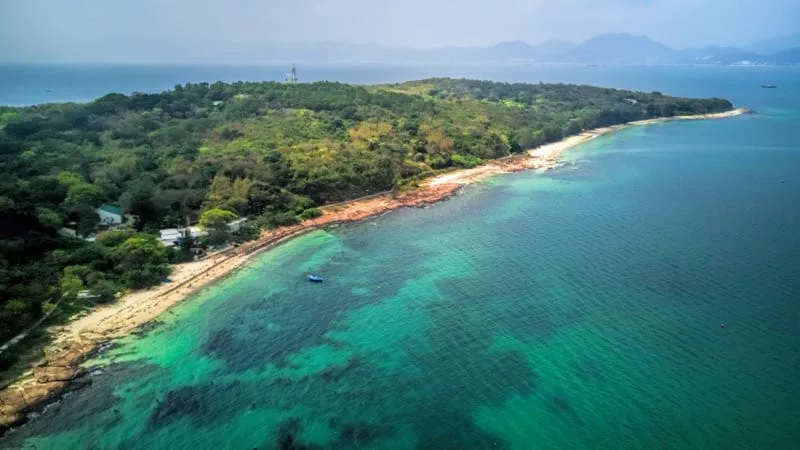
Tung Ping Chau is another densely vegetated island. It was home to a relatively dense population, so faced intense pressures from farming, but as there are no longer any residents, once open areas are becoming scrubland and woodland. Trees include Chinese Hackberry Celtis sinensis, Pond Spice Litsea glutinosa, Acacia Acacia confusa and figs such as Chinese Banyan.
There are also islands – particularly those such as the Ung Kong Group that are exposed to winds and waves – where the vegetation is little more than low scrub. These support relatively sparse biodiversity on land.
Scattered fung shui woods, beside old villages that in some cases have crumbled to ruins, augment species diversity on land. Lai Chi Wo, beside Double Haven, boasts one of the best fung shui woods in Hong Kong. Over 100 plant species have been recorded here, including the Incense Tree, and uncommon plants such as Langkok Fig Ficus langkokensis and Golden-leaved Tree Chrysophyllum lanceolatum. The upper part of the wood was included in Plover Cove Country Park, and in 2005 the lower section of wood became a Special Area, managed by the Agriculture, Fisheries and Conservation Department for conservation and education purposes.
The wood is also notable for some grand old trees, and four Lai Chi Wo trees are included in the government’s Register of Rare and Valuable Trees.
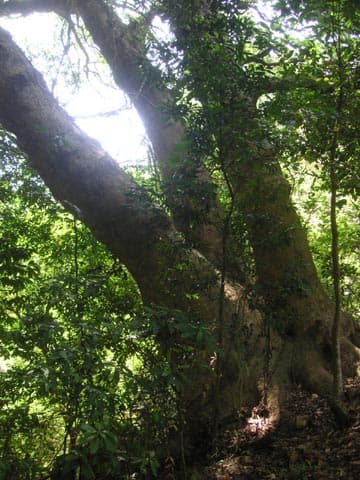
One of these trees is known as the Five-fingered Camphor, at the southwest corner of the village. This large Camphor Tree Cinnamomum camphora is so named as it formerly had five trunks that grew from ground level. During the Japanese occupation in the 1940s, Japanese soldiers threatened to chop down the whole tree – perhaps to reduce cover for guerrillas, but villagers rallied to the tree’s defence, and one trunk was felled instead. Even with four “fingers”, this tree is impressive: at the base, its diameter is over 3 metres, and the crown spreads some 29 metres.
Nearby is an Autumn Maple – or Javanese Bishopwood – Bischofia javanica, which is 23 metres high and has a trunk more than 2.5 metres in diameter. The roots of a Chinese Banyan Ficus microcarpa have formed a lattice around the maple. The banyan is growing in classic strangler fig fashion; its roots are competing for nutrients and water. If out-competed by the banyan, the Autumn Maple will die, and rot away to leave the banyan.
At the northwest corner of Lai Chi Wo is another Autumn Maple. This one is called the Hollow Tree, as its inside has rotted away, leaving an empty space big enough for a person to fit inside, with a gaping hole through the bark. It’s over 100 years old, and 18 metres tall, with branches spreading 15 metres at its crown.
The fourth of Lai Chi Wo’s “rare and valuable” trees is just below and east of the village. It’s a Chinese Banyan that’s 18 metres tall and over 100 years old, and is a marvellous example of a Hong Kong village banyan tree.
Land animals
Hong Kong’s grassland, scrub and secondary woodland are home to fair numbers of larger animals such as Wild Boar, Masked Palm Civets, Small Asian Porcupines Hystrix brachyura, Leopard Cats Felis bengalensisand Burmese Pythons Python molurus bivittatus. But, like the great majority of local m ammals and many of the reptiles and amphibians, these are nocturnal, so rarely seen by most people. Some leave signs that can be found during daytime, like roughly dug soil where wild boar have been rooting for food, and sharp-tipped porcupine quills. A small deer – Red Muntjac Muntiacus muntjak – inhabits the eastern New Territories. It too is shy and mainly active at night, but males announce their presence with loud barking calls that led to the name “Barking Deer”.
Burmese Pythons Python molurus bivittatus grow to around six metres in length, and can prey on young deer and wild boar – killing by constricting. Hong Kong also has 14 species of venomous land snakes, the most impressive of which is the King Cobra Ophiophagus hannah, which is the world’s longest venomous snake, growing to six metres long, though more typically reaching three to four metres, and specialises in feeding on other snakes.
Skinks – smooth scaled lizards – are the most readily seen of the common reptiles; on warm days, they dart for cover as hikers stride along woodland trails. Larger Changeable Lizards Calotes versicolor, with spiny back ridges, can seem unafraid of people, even curious, yet are always ready to scuttle swiftly away.
Amphibians include abundant Günther’s Frogs Rana guentheri, which contribute load gruff croaks to the frog choruses that reverberate around the countryside on rainy spring evenings. Asian Painted Frogs Kaloula pulchra have an even more distinctive call, sounding like the moo of a disgruntled cow. Along streams through woodland, there’s a chance of finding Hong Kong Newts Paramesotriton hongkongensis, which are unique to Hong Kong and coastal Guangdong province.
In spring and summer, woods resonate to the buzzing of cicadas. On Tung Ping Chau, cicadas can also be heard during autumn days. These are Meimuna silhetana, which was a new species for Hong Kong when a specimen was collected here in 2001. This cicada is yet to be found elsewhere in the territory.
Tung Ping Chau’s ecosystem is unbalanced – a fact reflected in recent years, when Black Tree Ants Polyrhachis dives (which are dark brown rather than black, and mainly nest in shrubs) have become super-abundant. These ants can festoon some paths and even stretches of the east coast, though are perhaps patchily distributed. Wandering onto visitors’ feet and legs, the ants readily nip the skin: not painfully, but noticeably enough to be irritating. Their abundance may reflect a lack of competition, and a lack of ant predators, such as Asian Common Toads Bufo melanostictus.
Butterflies are among the most readily seen animals across Hong Kong. Though some are tiny and inconspicuous, noticed only by experts, there many larger, eye-catching species, such as the swallowtails, which tend to have gorgeous colours. Common Tigers Danaus genutia have black latticework across their orange wings; they flap and glide slowly and casually, their self assurance stemming from toxins that make them unpalatable to birds and other would-be predators. The tigers are among butterflies that migrate from mainland China to Hong Kong in autumn, sometimes gathering in hundreds or thousands at sites that are sheltered from chill winds.
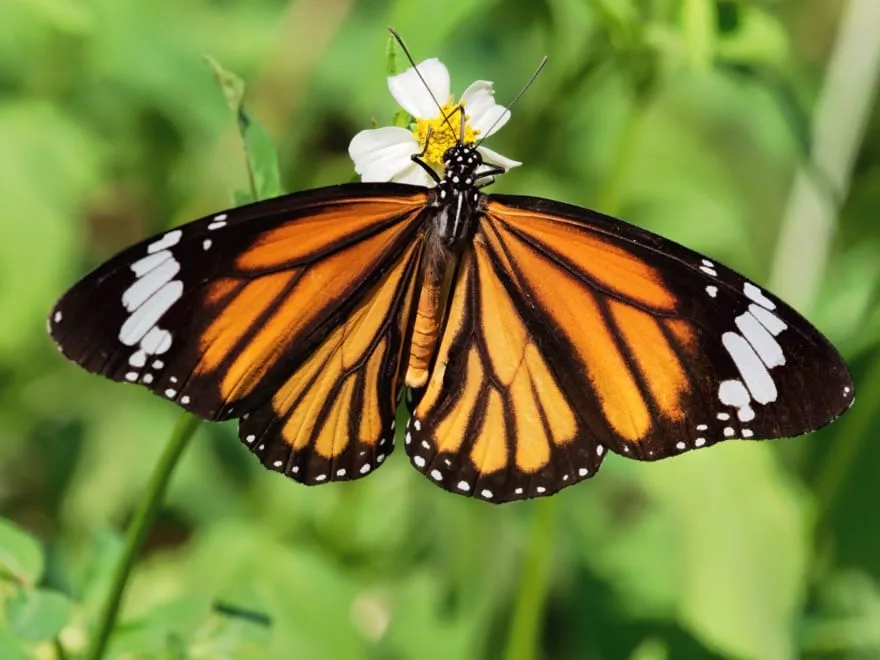
Plover Cover Country Park – including alongside Double Haven – is among the best areas for butterflies. Around half of all Hong Kong’s butterfly species have been recorded here. They include uncommon species, such as Club Silverline Spindasis syama, Common Awl Hasora badra and Great Swift Pelopidas assamensis.A species new to Hong Kong, Yellow Coster Acraea issoria, was recently sighted in an abandoned agricultural field here.
Though there are more than ten times as many moth species as butterflies, they are overwhelmingly nocturnal, so not readily seen by most people. They include the Atlas Moth Attacus atlas, which has the largest wingspan of any moth: each wing is as big as a hand. Hummingbird hawk moths are fat-bodied insects that feed on nectar. Emerging around dusk, they hover briefly in front of flowers, drinking nectar, and move swiftly to their next meals As their wings are blurred by rapid beating, they may be mistaken for hummingbirds, which only occur in the Americas.
Like butterflies, birds are conspicuous, and their numbers and species diversity reflect the quality of habitats. The best variety of resident land birds is found in the woodland of the central New Territories, particularly in Tai Po Kau Forest Reserve. Here, there are some of Hong Kong’s most brilliantly coloured birds, such as Scarlet Minivet Pericrocotus flammeus, Fork-tailed Sunbird Aethopyga christinae, Orange-bellied Leafbird Chloropsis hardwickii, Fire-breasted Flowerpecker Dicaeum ignipectus and Scarlet-backed Flowerpeckers D. cruentatum. Forest birds also occur in the secondary woodland and fung shui woods of the eastern New Territories, including in and near Geopark sites.
Because Hong Kong was severely deforested, many forest birds that once occurred here have been lost: for instance, woodpeckers became locally extinct. This resulted in the resurgent woods having many empty niches, which could not be filled by the species that clung on here, or which have re-colonised from the remaining forests in nearby China. Some cage birds that have escaped or been released from captivity have occupied some of these niches, and Hong Kong’s woods are now home to substantial populations of several non-native birds, such as Silver-eared Mesia Leiothrix argentauris and Blue-winged Minla Siva cyanouroptera.
In scrubland, birdlife is sparser, though it’s typically easier to see birds than in dense woodland. Chinese Bulbul Pycnonotus sinensis and Red-whiskered Bulbul P. jocosus are common, Long-tailed Shrikes Lanius schach watch for prey from prominent perches, and Yellow-billed Prinias Prinia flaviventris are among the small birds favouring grassy areas.
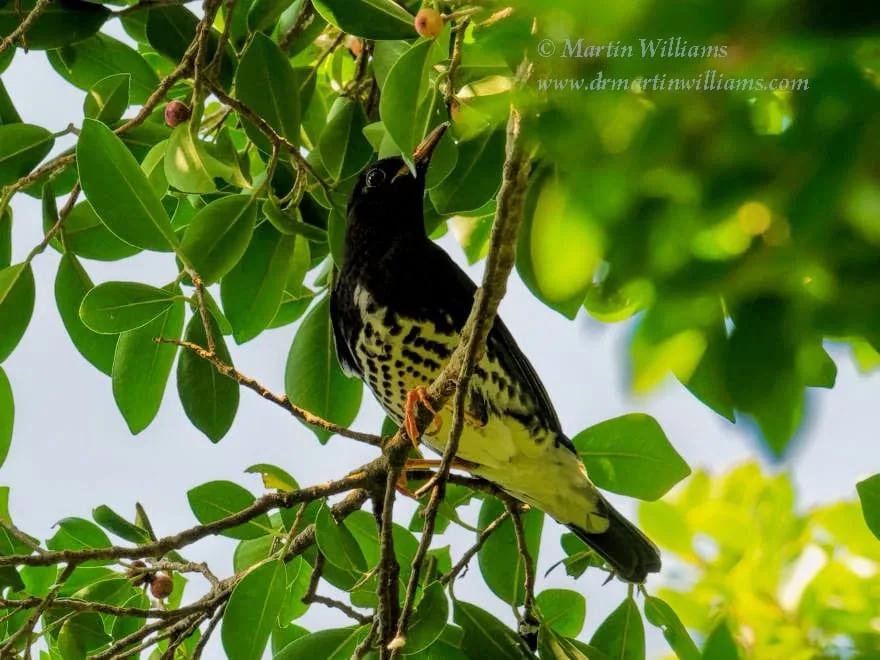
Partly thanks to its location within Mirs Bay, which is open to the South China Sea, Tung Ping Chau is attractive to migratory landbirds, such as warblers, thrushes and flycatchers. These are mainly found in the small woods along short side-trails.
Especially in early April, the flycatchers include some of Hong Kong’s most beautiful birds. Blue-and-white Flycatchers Cyanoptila cyanomelana and Narcissus Flycatchers Ficedula narcissina – are brilliantly coloured: male Narcissus Flycatchers are intense orange-yellow below, black above, with white wing patches and yellow “eyebrows”. Male Japanese Paradise-Flycatchers Terpsiphone atrocaudata are maroon above, grey below, with blue eye-rings and long tail streamers: they’re stunning birds, and are globally threatened with extinction, chiefly because of deforestation in their wintering areas in southeast Asia.
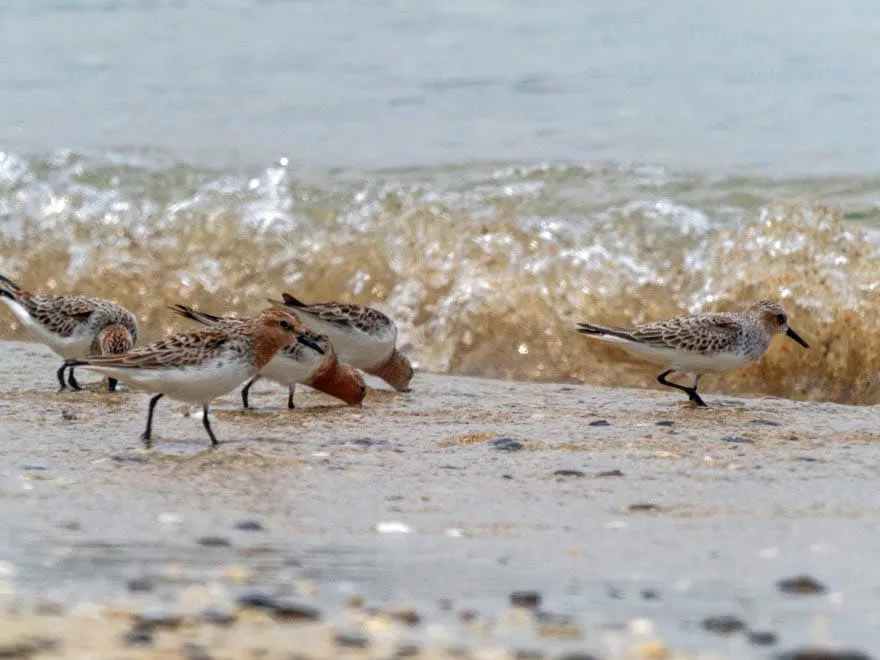
Tung Ping Chau also attracts some migratory shorebirds, such as Red-necked Stints, Ruddy Turnstones and sandplovers.
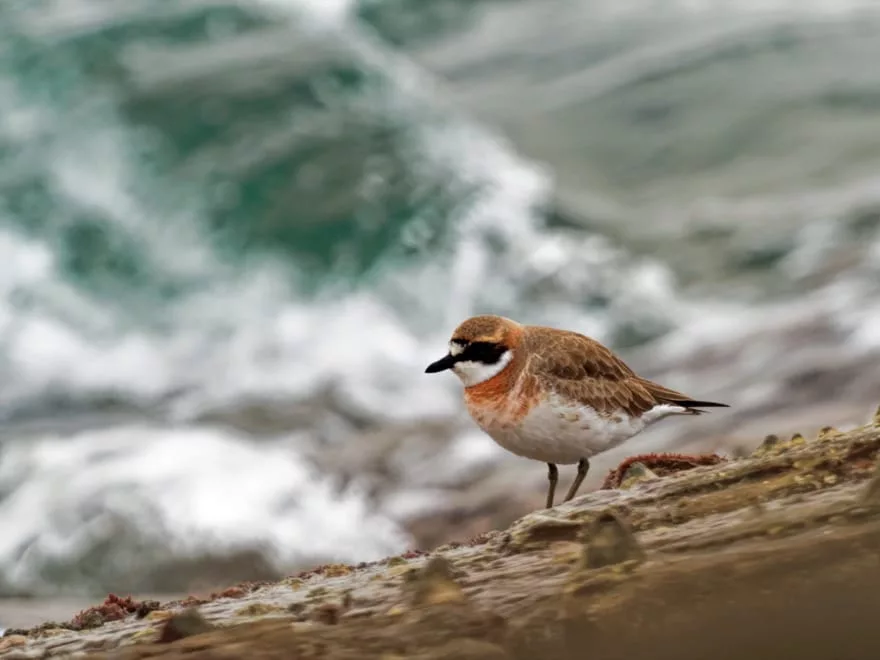
Coastal and Marine Biodiversity
Mangroves and Eel Grass
At many Hong Kong stream and river mouths, there are mangroves, with species assemblages including true mangrove trees, which are adapted to a life on tidal sand and mud, and grow below the high tide line.
By far the largest stand of mangroves – and one of the largest mangrove areas in south China – is at Deep Bay, in northwest Hong Kong. Here, the complex of estuarine mudflats, mangroves and shrimp ponds and fish ponds comprise an internationally important wetland that’s a haven for waterbirds.
Tens of thousands of waterbirds spend winter in Deep Bay. Great Cormorants Phalacrocorax carbo, Common Black-headed Gulls Larus ridibundus, ducks such as Northern Pintail Anas acuta and Northern Shoveler A. clypeata and waders such as Kentish Plover Charadrius alexandrinus and Pied Avocet are the most abundant species. There are also globally threatened Black-faced Spoonbills – around a third of the world population of this species occurs on migration or overwinters in the bay, Saunders’ Gulls L. saundersi and Eastern Imperial Eagles Aquila heliaca.
Global warming and destruction of and damage to wetlands from northeast Asia to Australia – which lie on the flight paths of waterbirds occurring in Hong Kong –have led to numbers of several species falling in Hong Kong. Once readily seen Falcated Ducks A. falcate are now scarce; Common Shelduck Tadorna tadorna numbers have plummeted from thousands to double figures; flocks of up to 70 Dalmatian Pelicans Pelecanus crispus were seen in the 1970s, yet it has become hard to see even one in recent winters; and Black-headed Ibis Threskiornis melanocephalus was scarce but annually seen, yet now seems locally extinct. By contrast, numbers of Pied Avocets have ballooned from under two thousand to well over ten thousand.
Many more waterbirds pass through on migration, notably a wide variety of shorebirds. Again, there are globally threatened species, such as Nordmann’s Greenshank Tringa guttifer and Spoon-billed Sandpiper Eurynorhynchus pygmeus.
Though waterbird numbers are far lower at Hong Kong’s other mangrove sites, they hold a wide range of plants and other animals, several of which are not found in Deep Bay.
Most of Hong Kong’s mangrove trees are small, with spindly trunks. The exceptions are at Lai Chi Wo, where there is a small wood that’s like a fragment of primeval forest. The trees here are Coastal Heritiera – or Looking-glass Mangrove – Heritiera littoralis, and are large, with substantial buttress roots supporting thick trunks. The trees are hung with the thick stems of a climber, White-flowered Derris Derris alboruba. Some of these stems are 20-30 centimetres across, and this climber is over 100 years old.
There’s also a stand of typical Hong Kong mangroves at Lai Chi Wo. Including Heritiera, all Hong Kong’s eight native species of true mangroves are found here.
Also at Lai Chi Wo, on the tidal mudflats beyond the mangroves, there is a bed of Japanese Eel Grass Zostera japonica. This is a kind of sea-grass – flowering plants (angiosperms) that have developed methods for flowering and pollination underwater.
Both mangroves and sea-grass are important habitats for marine life, such as juvenile fish including sharks. They also help stabilise mudflats, and protect coastlines against storm damage.
The Coral Triangle – and Yan Chau Tong Marine Park
Double Haven is at the western edge of a region that marine biologist P.O. Ang has dubbed the “coral triangle”; Tung Ping Chau is at the eastern corner, and the southern corner is at Hoi Ha Wan on the Sai Kung Peninsula. As the name suggests, this area is home to a diverse marine life, including corals. Most of the 84 species of stony corals recorded to date in Hong Kong can be found here, in oceanic waters away from the influence of the Pearl River. However, as stony corals grow best in warm water, and Hong Kong has relatively cool winters, with sea temperatures sometimes falling to 15ºC, corals here don’t form major reefs.
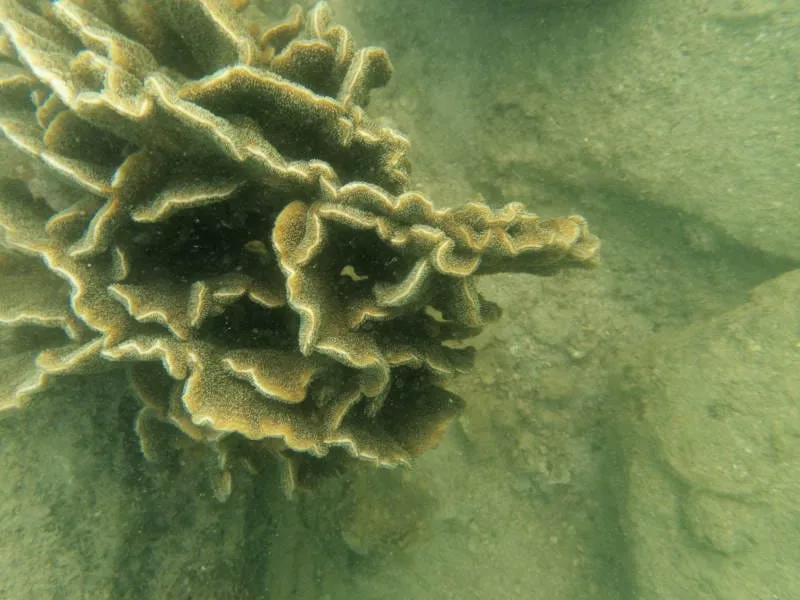
Remarkably given it is so small, Hong Kong has over 10 percent of the world’s stony coral species. The mix of species is unique: although many are widely found across tropical areas of the Indo-Pacific (which includes the Indian and Pacific oceans), there are some species that are normally restricted to only parts of this region – such as Alveopora gigas from Australia and Papua New Guinea in the south, and Acropora japonica from Japan in the north.
Thanks to the cool winters, Hong Kong is also home to other more northern (temperate) marine life, such as the marine macro-algae that are commonly known as seaweeds. Growing mainly in winter, these compete for sunlight, and may prevent corals becoming established in places that may be otherwise suitable.
A host of other marine animals and plants includes species that are dependent on corals for food and shelter. For instance, over 130 species of reef-associated fishes and over 100 species of marine invertebrates such as shellfish, sponges and crabs have been recorded around Tung Ping Chau.
The stony corals (or hard corals) are colonies of anemone-like creatures – the individuals of which are polyps – which grow in protective limestone skeletons, often together with symbiotic algae. The algae are characteristic of the reef-building corals and, as they require light for photosynthesis, these corals are restricted to shallow water with ample sunlight.
Hong Kong is the only place in the world where brain corals in the genus Platygyra are relatively abundant and often large. Named because their surface patterns resemble the convolutions of a brain, these corals can form castle-like structures up to two metres high. These “castles” are among the most distinctive features of the local coral communities, helping to create bizarre underwater landscapes.
Another of the common corals in this area is Favia speciosa, which also forms massive colonies, though these lack the turrets of Platygyra. Also, because each polyp is surrounded by a skeletal wall rather than sharing with neighbours, the surfaces have honeycomb rather than brain-like patterns. The finger corals Porites lutea and P. lobata may also form small mounds, though as the polyp cavities are smaller, their surfaces appear smoother.
The Crusty Star Coral Leptastrea purpurea is also common here, though easily overlooked as it grows across rock surfaces. Lithophyllon undulatum may also grow as an encrusting coral, and as overlapping plates.
Tung Ping Chau is among the best coral sites; some 61 of Hong Kong’s 88 known species of hard coral have been recorded around the island. The dominant species include two closely related brain corals, Platygyra acuta and Platygyre carnosus, which both form castle-like structures that are striking features of the underwater landscape: these can be visible from the surface, including from the ferry pier, though it’s best to snorkel or dive to really see the coral. Other corals include the crater coral Leptastrea purpurea, which tends to be encrusting – growing across rock surfaces, or sometimes forms low, rather sprawling structures.
Kiu Tsui boasts one of the most easily accessed coral communities in Hong Kong. The main area of corals lies south of the tombolo, and is marked by buoys that designate a no anchoring zone. Snorkelling here, you can readily see coral heads, along with other marine creatures such as urchins and colourful fish.
At Ung Kong Wan, north Bluff Island, there is one of Hong Kong’s best hard coral communities. This bay is popular with visitors arriving by pleasure boat, and the coral here formerly showed significant damage by boat anchors. However, this became the first place in Hong Kong where buoys were placed to mark a no anchoring area, and this measure has proven successful, with recent Reef Check surveys showing an increase in coral coverage.
Ung Kong Wan is the most sheltered place in the Ung Kong Group, and away from here hard corals are scarcer. There are, however, soft corals, as well as a wide variety of fish and other animals.
Port Island is one of Hong Kong’s best dive sites, though divers must take care with potentially dangerous currents. Soft corals are plentiful, and there are communities of hard corals, dominated by massive corals in the family Faviidae, such as brain corals Platygyra spp. and honeycomb corals Favia and Favites spp.
Since 1846, over 580 species of fish have been recorded in Hong Kong’s coral communities since 1846. Although this is a high total, there is an overall paucity of fish, especially large and adult fish. This was clearly revealed during a study in 1997 and 1998, which estimated the average mass of fish per cubic metre over the best coral areas was among the lowest ever recorded in the Indo-Pacific: the figure of 20-30 grams was around a tenth of that reported from Australia’s Great Barrier Reef.
The fish study yielded a surprising result for the top species in terms of biomass: Silver Sweeper Pempheris oualensis, a nocturnal species that had not been previously recorded in Hong Kong. Together with just eight other species, this accounted for over 90 percent of the individual fish recorded, and 75 percent of the biomass.
Some of the fish feed on corals. Beautifully patterned butterfly fish, with elongated mouths looking ready to kiss, nibble on polyps. Parrotfish, named for their parrot-like beaks, can bite off small chunks of coral, as well as graze on algae.
Various species of wrasses are among the commonest and most colourful fish in the coral communities, feeding on animals including bivalves and crabs. Coral Trout Plectropomus leopardus are scarce, but also colourful, usually red to greenish brown, with a multitude of blue dots.
Orange-and-black striped Clark’s Clownfish Amphiprion clarkii – looking straight from the movie Finding Nemo – live together with their host anemones Entacmaea quadricolor. Skin secretions protect them from the anemones’ stings, while these in turn help keep the clownfish safe by deterring predators, and the anemones get scraps of food from clownfish meals.
Groupers are among the predators here, lurking in crevices and lunging at prey. Moray eels likewise have their hideouts, from which they grab small fish. Sleek, fast Barracuda Syphraena sp. are top-level predators of the open water that hunt in packs.
Scorpion fish prefer to lie in wait, relying on their cryptic patterns and outlandish to appear unlike living creatures, so unwary animals swim too close and – gulp! – are promptly eaten. The spines of their fins are equipped with poison, for defence: and this makes them dangerous to humans, as the stings are intensely painful, and can cause nausea and even paralysis.
The invertebrates in coral communities also include species that can harm humans, along with a great many others that are benign. The Black-spined Urchin Diadema setosum is among these. It has long, sharp spines it can point towards shadows as predators maybe approach, and are equipped with a toxin. Despite these spines, on typical Indo-Pacific reefs these urchins typically hide from predatory fish by day, and feed at night. Here in Hong Kong, however, they are readily seen in daytime – perhaps because a formerly common urchin predator, Black-spot Tuskfish, Choerodon schoenleinii, has been over-fished and is now rare, and lost from our commercial fishery, as it was among the most expensive local and imported reef fish. Now, however, it appears the sea urchins are in turn being over-harvested, especially by fishermen from mainland China.
The Textile Cone Conus textile and Blue-ringed Octopus Haploclaena maculosa have potent venom that is primarily for killing prey, though can be used in self-defence. The Textile Cone hunts animals such as small fish, firing a “harpoon” to inject them with a toxin that paralyses and kills them. Blue-ringed Octopuses use a very similar venom – and though the body is only the size of a golf ball, each has enough venom to kill 26 human adults within minutes. They chiefly prey on crabs and shrimps, and usually blend into their surroundings – though if danger threatens, pigments make their blue rings conspicuous and so warn: Danger – stay away.
Mantis Shrimps Gonodactylus falcatus don’t bother with toxins, but instead have claws that can strike with blinding speed. This species belongs to the group of mantis shrimps which have club-like claws and are dubbed “smashers” for their ability to bash through thick bivalve shells, or even smash fingers or thumbs of careless divers. In the UK, a four-inch long mantis shrimp broke the quarter-inch glass of an aquarium – and was named “Tyson” after boxer Mike Tyson.
Many other creatures have equally successful, but less spectacular ways of feeding. A wide variety of worms live here, some boring into the coral. Members of one group of worms, the brittle stars, may have five whip-like arms, which they use to move around, and to feed on detritus and smaller animals. Sponges remain fixed in place, pumping water through their bodies to filter plankton. Barnacles are among other filter feeders.
Jellyfish drift through the water, catching plankton with stinging tentacles. Though most species are not strong enough to harm people, a few can cause paralysis. In places such as Japan, the Mediterranean and Namibia, there have been recent increases in jellyfish swarms (or blooms), and these may be related to over-fishing: as fish stocks fall, plankton increase, in turn leading to jellyfish multiplying.
On the seabed, crabs scuttle about to find prey, and scavenge. Some snails (gastropods) graze on algae; one of them – Magilus seriatus – feeds exclusively on Favia corals, ingesting food particles in the mucus surrounding polyps.
Nudibranchs are carnivorous sea slugs (shell-less snails), and may be strikingly patterned. Some have cryptic camouflage, but others are so brightly coloured they are sometimes known as the butterflies of the ocean. Some of them feed on hydroids, and can do so without triggering their stinging nematocysts – instead transferring them to tentacles where they retain their stinging power, and so help deter any creatures that might otherwise make a meal of the nudibranchs.
Seaweeds
There are seaweeds – which are better termed marine macro-algae – in Mirs Bay, especially along the south and west coasts of Tung Ping Chau. Over 44 species have been recorded here to date. Growing best in cooler water, they are most prominent during winter and early spring, especially from January onwards.
Some of the seaweeds are green, such as Sea Lettuce Ulva fasciata, fronds of which may be up to a metre long. Others are brown, including one of the most plentiful seaweeds here, Sargassum, which can grow to several metres in length. The seaweeds host an array of marine creatures, including hydroids and – rarely – the bizarre Sargassum Fish Histrio histrio. This extraordinary fish is cryptically patterned and has fins and tail that are little use for swimming, but superb for disguising it as part of the waving fronds of seaweed: perfect for evading predators, and for allowing smaller fish and other animals to approach, and become Sargassum Fish food.
People sometimes harvest seaweeds for food. They indeed contain many vitamins and minerals, and may have medicinal properties. Extracts from seaweeds collected at Tung Ping Chau have been shown to reduce liver damage in laboratory rats; an extract from Hong Kong Sargassum has been found to inhibit the attachment of Herpes simplex virus to its host cells.
Whales, dolphins and porpoises
Whales are rare visitors to Hong Kong; they have included the territory’s first-ever Humpacked Whale Megaptera novaeangliae, which made local headline news during its appearance in April 2009.
There are, however, a resident dolphin and a porpoise. The dolphin is the far better known of the two. Though it’s called Chinese White Dolphin, the adults are bubble-gum pink when adult – with this colour resulting from blood showing through their skin. Youngsters are grey, becoming dappled grey and pink as they mature. The dolphin inhabits waters in the Pearl River Mouth, especially along the north and west coasts of Lantau Island. Its population has declined, and only around 1400 survive in the Pearl River Mouth; they face an array of threats, including pollution and developments impacting the inshore waters.
The Finless Porpoise Neophocaena phocaenoides is far less renowned, although the species is scarce in China. This is partly because even adults grow to only around 1.8 metres in length. As they are grey, have no fins, and seem intent on keeping a low profile, not jumping from the water, they are remarkably unobtrusive. Even when one surfaces for air, it looks like little more than a large tyre bobbing up, and vanishing. The porpoise favours southern and eastern waters, including in the vicinity of the Ninepin Group and off the Sai Kung Peninsula.
Migratory seabirds – including nesting terns
Migratory seabirds are recorded Hong Kong’s southern and eastern waters, but though there is a fair diversity, numbers of individuals tend to be low. Even gulls are hard to find, even though gulls are typical of coastal areas in much of the world.
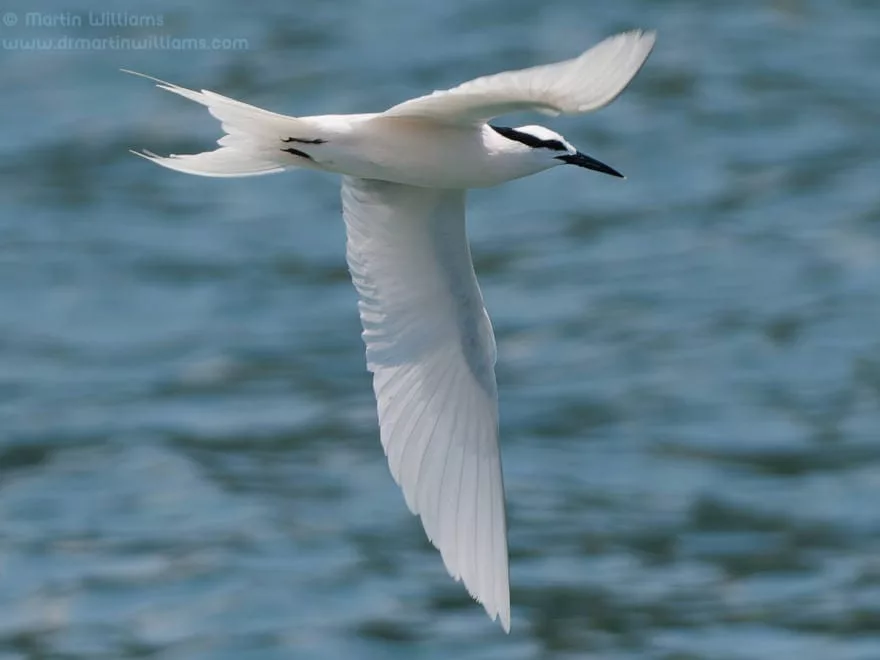
The most dependable seabirds in these waters are terns that arrive to breed in late spring. Terns are elegant birds, which catch fish by plunging quickly to the water. Three species – Black-naped Tern Sterna sumatrana, Roseate Term S. dougallii and Bridled Tern Onychoprion anaethetus breed in Hong Kong. They form small colonies on islets, including within the Ninepin Group, and greatly enliven the stark rocks.
Terns do, however, suffer from disturbance by people. Anglers may arrive by boat, and climb on islets to then spend hours fishing – scaring anxious adult terns that should be sitting on eggs, or feeding and shading chicks. Casual visitors and even over zealous bird photographers might also disturb the terns.
Other seabird species mainly occur as spring and autumn passage migrants, with numbers seen on any day varying with date, and weather. Perhaps the most noteworthy of these is Aleutian Tern O. aleutica.
Aleutian Tern breeds in northeast Asia and the northwest United States, including on the Aleutian Islands within the Bering Strait. Until 1992, this tern was virtually unknown away from its breeding grounds. But in autumn that year, around 190 Aleutian Terns were seen in Hong Kong, and it has since proven to be a regular migrant, chiefly in autumn but with small numbers in spring.
Other migratory seabirds that are occasionally seen here include Long-tailed Skua Stercorarius longicaudus, a handsome bird that flies with the buoyancy of terns, yet is sometimes a pirate: chasing birds like terns that have caught fish, and harrying them until they drop their prey, which the skuas snatch and eat.
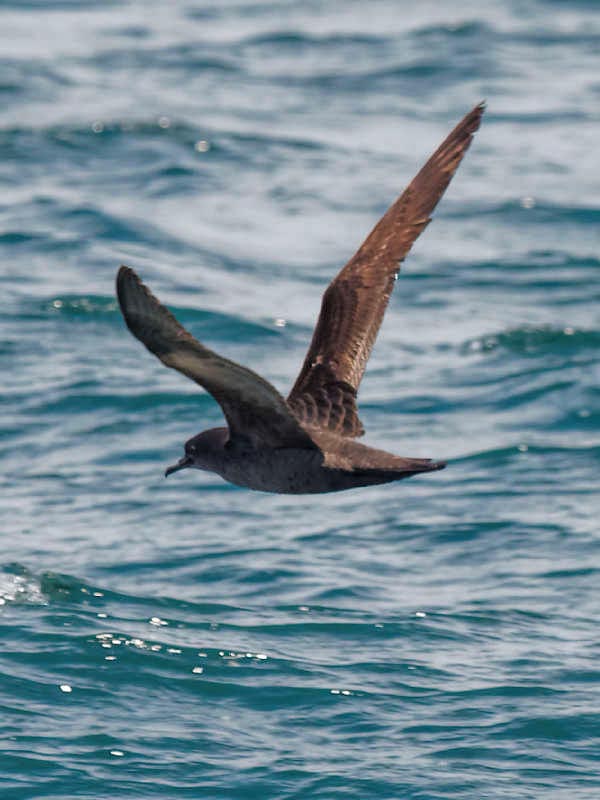
Shearwaters – smaller cousins of albatrosses – can also be found, mainly in late April. Like albatrosses, they are masters of flying over ocean waves, using long wings outstretched to ride air currents ahead of the waves, flapping briefly, and languidly tilting to one side as they soar upwards, then dip again to catch another wave. The two main species in Hong Kong are Streaked Shearwater Calonextris leucomelas and Short-tailed Shearwater Puffinus tenuirostris.
More abundant are Red-necked Phalaropes Phalaropus lobatus: small, dainty shorebirds that swim buoyantly, picking up plankton. Their numbers usually peak around the end of March, especially when inclement weather causes many of them to halt their migrations. At such times, there may be thousands of them in Hong Kong waters – and there’s no need to travel as far as the Ninepin Group to find them, as a few individuals might even be seen from the Star Ferry in Victoria Harbour.
Egrets and eagles
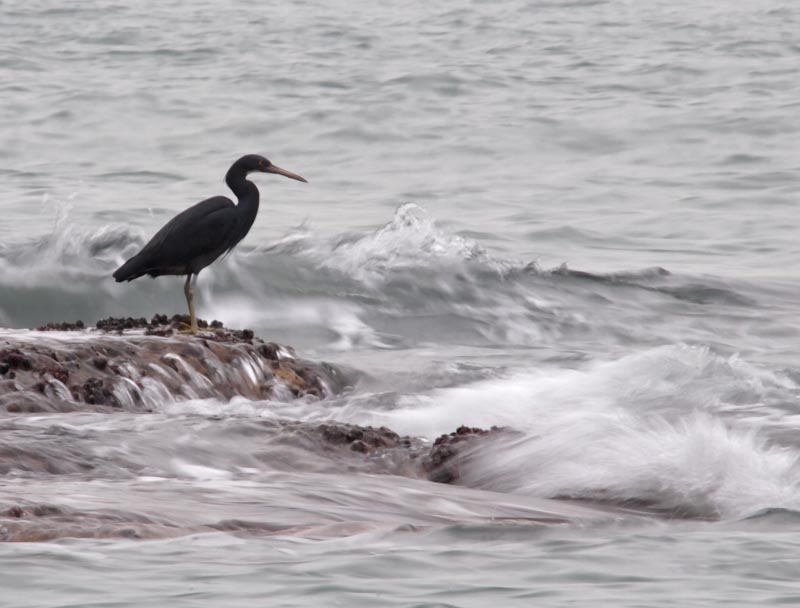
Four species of egrets breed in Hong Kong. Three of these have mostly white plumage, and favour freshwater wetlands and tidal mudflats. The other species – Pacific Reef Egret Egretta sacra – has slate-grey plumage, and mainly frequents rocky shores, including at several Geopark sites.
An eagle also occurs at wilder stretches of coastline. This is the White-bellied Sea-Eagle, which is larger than the Black Kites Milvus migrans that are commonly seen in Hong Kong, with a wingspan of around two metres or more. The eagles nest on cliffs or trees above the coast, rearing young that are initially brown, but acquire the distinctive grey, black and white plumage as they mature. While kites glide on flat wings, the eagles hold theirs up slightly, in a shallow V, and can be seen soaring on updrafts over hills and islets throughout the Geopark.



